Hurricane eMatrix
List of Activity Sheets » Waste debris removal and reduction
Debris Reduction, Recycling, and Disposal
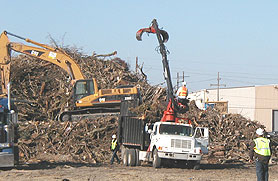
This picture shows actual disaster site work conditions and may not illustrate proper safety and health procedures.
Activity Description
- This activity sheet is for those response and recovery workers conducting debris reduction, recycling, and disposal efforts, those who work in areas where this activity is occurring, and those who supervise these activities.
- For some operations or situations (e.g., heavy equipment use, work zone safety, and trenching) other activity sheets also apply; see related activity sheets below.
- As a result of Hurricanes Katrina and Rita (2005), it is estimated that over 80 million cubic yards of debris have been generated. This debris includes building materials, furnishings, trees, and hazardous wastes. To reduce the burden on landfills from this large quantity of waste, response organizations are taking every effort to reuse, recycle, and reduce the debris. They segregate debris that may be reused (e.g., mulch from downed trees, aggregate made from concrete building materials) or recycled (e.g., metals). They are also collecting, categorizing, and disposing of white goods (e.g., refrigerators and air conditioners) and hazardous wastes (e.g., Freon�, oils, and household hazardous wastes such as cleaners, paints, and pesticides) in accordance with standard protocols.
- Debris is initially sorted using heavy equipment (e.g., bulldozers, dump trucks, grapplers) and then is sorted manually. Heavy equipment is used to move large volumes of debris and debris that cannot be handled manually. In the next sorting step, manual labor and some other equipment, including heavy equipment such as forklifts and front-end loaders, is needed to remove any incompatible materials (e.g., metal furniture or hazardous materials from wood to be burned).
- Once sorted into debris types, non-hazardous wastes that do not need to go directly to a landfill are often reduced by chipping, grinding, or burning on-site using specialized equipment. This specialized equipment often includes shakers to further refine the debris, tub grinders and wood chippers to reduce the size of the debris, and air-curtain incinerators to increase the efficiency of incineration and decrease incinerator-related air emissions.
- Response and recovery workers conducting this operation may be employed by Federal, State, local, and private employers. Review How to Use This Matrix in the introduction for a discussion of how this information may apply to different workers.
About the Activity Sheet
This activity sheet does not provide an in-depth analysis of OSHA standards and regulations and cannot address all hazards. It does not increase or diminish any OSHA requirement or employer obligation under those requirements. It is intended as a guide and quick reference for employers and response and recovery workers. The Matrix captures major activities involved in hurricane response and recovery, highlights many of the hazards associated with them, and recommends beneficial work practices, personal protective equipment (PPE), and other exposure control methods. Employers must evaluate the specific hazards associated with the job/operation at the site where the work is being performed.
Employers are responsible for providing a safe and healthful workplace for their workers. OSHA's role is to assure the safety and health of America's workers by setting and enforcing standards; providing training, outreach, and education; establishing partnerships; and encouraging continual improvement in workplace safety and health.
The Hazard Exposure and Risk Assessment Matrix for Hurricane Response and Recovery Work provides a general overview of particular topics related to current OSHA standards. It does not alter or determine compliance responsibilities in OSHA standards or the Occupational Safety and Health Act of 1970, or the equivalent State Plan standards and requirements. Because interpretations and enforcement policy may change over time, you should consult current OSHA/State Plan administrative interpretations and decisions by the Occupational Safety and Health Review Commission and the courts for additional guidance on OSHA compliance requirements. Employers should modify their procedures as appropriate when additional, relevant information becomes available.
Activity-Specific Sampling and Monitoring Information
- PPE issues were found at roughly half the work sites OSHA observed. PPE, including hard hats, hearing protection, and respirators, was either not being worn when needed, or the PPE selected did not provide adequate protection.
- Other common concerns included inadequate work zone safety controls and falls from elevated surfaces.
- Response and recovery workers conducting this activity were among the groups most likely to be exposed to hazardous levels of noise, dust, and crystalline silica. Sample results for these hazards show that individuals at debris reductions sites may be exposed above allowable levels (i.e., OSHA's PEL), particularly when they operate machinery and heavy equipment.
- For safety and health monitoring data and sample results, see Summary of Activity Sampling Data and Safety and Health Monitoring Information.
General Recommendations
Key Engineering Controls and Work Practices. See general recommendations document.
Personal Protective Equipment. The general PPE is recommended for all response/recovery tasks/operations; only the additional PPE that may be needed for a specific hazard is noted below.
General PPE includes:
- Hard hat for overhead impact or electrical hazards
- Eye protection with side shields
- Gloves chosen for job hazards expected (e.g., heavy-duty leather work gloves for handling debris with sharp edges and/or chemical protective gloves appropriate for chemicals potentially contacted)
- ANSI-approved protective footwear
- Respiratory protection as necessary-N, R, or P95, filtering facepieces may be used for nuisance dusts (e.g., dried mud, dirt and silt) and mold (except mold remediation). Filters with a charcoal layer may be used for odors
Recommendations Specific to Hazards Associated with Debris Reduction, Recycling, and Disposal
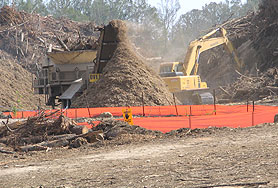
- Equipment operated in close proximity to burn pits should be equipped with temperature-controlled cabs. This is recommended for all heavy equipment at debris reductions sites, to reduce exposures to noise and particulate and to reduce the risk of heat related illnesses. However, it is most critical for the equipment operated in close proximity to burn pits.
- See Heavy Equipment and Powered Industrial Truck Use activity sheet
- See Crane Use activity sheet
- See Use of Aerial Lifts activity sheet
Additional Personal Protective Equipment
- Hearing protection-see Noise hazards
- When working from an aerial lift, use a body harness that is properly attached (or body belt for tethering or restraint use only) for fall protection
Key Engineering Controls and Work Practices
- See Work Zone Safety and Traffic Control within a Work Area activity sheet
Additional Personal Protective Equipment
-
ANSI/ISEA 107-2004 compliant high visibility safety apparel and headwear
Key Engineering Controls and Work Practices

- Do not wear loose-fitting clothing
- Follow the manufacturer's guidelines and safety instructions
- Guard the feed and discharge ports
- Prevent opening of access doors and covers until the drum or disc has completely stopped
- Prevent detached chippers from sliding or rolling by chocking the trailer wheels
- Maintain a safe distance between the machine operations and other work/individuals. This area should be free of nonessential equipment, vehicles, and personnel
- Never reach into the equipment while it is operating
- Use a lockout system when servicing or maintaining (e.g., "unjamming") equipment
Additional Personal Protective Equipment
- Eye and face protection appropriate for additional impact hazard
- Hand protection for cut- and abrasion-control
- Hearing protection-see Noise hazards
Key Engineering Controls and Work Practices
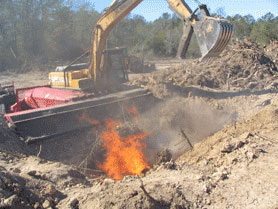
- Remove grasses and other flammable and combustible materials from the area around burning operations; embers from air burners can spread approximately 100 feet
- Ensure that fire extinguishers are available at work sites and on work vehicles
- Consider the need for public water supply and emergency medical and fire services when selecting debris incineration sites
- Provide separation between burn piles and structures, where possible (e.g., buildings and observation tower); ensure structures are upwind of burn pile location
- Establish conditions when burns should not be conducted (e.g., maximum/sustained wind speed)
- Maintain a fire watch during all fire-related activities until material has cooled
- Consult with the Fire Chief (or similarly experienced individual) regarding site-specific safety measures
- Consider the need to limit access (e.g., fencing, guards, covers for air burners) both during operation and when left unattended (e.g., at night)
- Stay upwind of burn piles; where possible, ensure that the observation tower is positioned upwind of burn area
- Monitor carbon monoxide exposure levels for workers (e.g., heavy equipment operators, fire watch) that are working near burning operations
- For chipping, shredding, and grinding operations:
- Periodically clear flammable material from the chipper drums, hammer and teeth, drive mechanism and other areas of the equipment. This can be done when operation is stopped for a significant length of time
- Periodically move equipment to limit the amount of combustible material in, under, and around the equipment
- When dry conditions exist, saturate the ground under and around equipment before, during, and after each shift
- Do not mount pressurize cylinders such as oxygen, acetylene, and propane on the equipment
- When performing hot work (welding, cutting, burning) on the equipment, saturate the ground under and around it with water
Additional Personal Protective Equipment
- Appropriate respiratory protection (particulate filtering or supplied air, as needed) and eye protection when working in or around smoke
- Thermal protective clothing and gloves for individuals needing to contact heated materials
- Long-sleeved shirts and pants when near the reduction pile
Key Engineering Controls and Work Practices
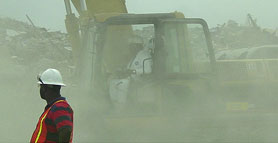
- Stay upwind of or away from dust-generating activities, and in particular those involving crystalline silica-containing materials like concrete, brick, tile, drywall, mortar, sand, or stone. When inhaled, the fine crystalline silica particles contained in the dust can become lodged deep in the lung, which can lead to silicosis and other respiratory illnesses
- Use water spray or mist to suppress dust generation, especially during operations that may create a lot of dust, such as cutting or sawing silica-containing materials, jack hammering, impact drilling, using heavy equipment, and demolishing structures
- Avoid using compressed air for cleaning surfaces
- Sample worker exposures to silica during dust-generating activities
Additional Personal Protective Equipment
- At a minimum, use respirators with N, R, or P95 filters for work with crystalline silica-containing materials (e.g., concrete, brick, tile, mortar). The use of N, R, or P100 filters may provide additional protection. Higher levels of respiratory protection may be needed for some operations (e.g., cutting concrete, sandblasting, mixing concrete)
- N, R, or P95 respirators may be used for nuisance dusts (e.g., dried mud, dirt, or silt) and mold (except mold remediation). Filters with a charcoal layer may be used for odors
Key Engineering Controls and Work Practices
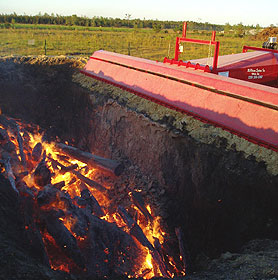
- In addition to the fire and smoke hazards:
-
Do not locate operations under or close to power lines
-
- For all air curtain burner operations:
- Position air curtain burners away from debris piles
-
Do not push the debris into the pit; this may compromise the integrity of the pit wall. Use the pick and drop method to load materials into the burner
- For air curtain burners using pits and blowers:
- Pit length should be no longer than the length of the blower
- Use wheel stops and berms to keep heavy equipment from affecting the structural integrity of the pit. Position wheel stops made of combustible materials (e.g., logs) so that they will not be affected by the heat and fire
- Inspect pits daily (see Trenches and Excavations activity sheet)
Additional Personal Protective Equipment
- See fire and smoke hazards
Key Engineering Controls and Work Practices
- Before starting, check controls, chain tension, bolts, and handles to ensure proper function and adjustment
- Start the saw on the ground or on another firm support with the brake engaged
- Plan the cut; watch for objects under tension; use extreme care to bring objects safely to the ground. Plan where the object will fall; ensure that the fall area is free of hazards; avoid felling an object into other objects; and ensure that a clear retreat path is provided
- Look for nails, spikes, or other metal objects before cutting
- Clear away dirt, debris, small tree limbs, and rocks from the chain saw's path
- Keep hands on handles and maintain secure footing
- To control or prevent chain saw kickback, push-back, and pull-in, use saws that reduce these dangers through chain breaks, low kickback chains, etc.; do not use the saw's tip and keep any tip guards in place
- Do not cut directly overhead
- Shut off/release throttle prior to retreating
- Shut off or engage chain saw brake when carrying a saw more than 50 feet or crossing hazardous terrain
Additional Personal Protective Equipment
- Chaps
- Hearing protection-see Noise hazards
- Eye protection appropriate for additional impact hazard
- Fall protection, as necessary-see general recommendations
Key Engineering Controls and Work Practices
- See Trenches and Excavations activity sheet
Key Engineering Controls and Work Practices
- Set up observation towers away from overhead power lines, upwind of burn pits, and away from chipping and other noisy operations, where possible
- Properly erect towers-ensure they are level, erected on firm ground, and are rated for intended load
- Provide stairs for access and a guardrail system for fall protection
- Secure towers, as necessary
- Barricade tower base and provide clearance for heavy equipment, including trucks and their loads
Key Engineering Controls and Work Practices

- "White goods" like refrigerators and air conditioners may contain chemicals such as Freon� and oils that may be recycled prior to discarding the appliance/equipment. Older refrigerators may also contain ammonia, sulfur dioxide, and other chemicals. White goods and household wastes such as cleaners, paints, and pesticides should be segregated and addressed as described here
- Segregate containers of hazardous materials by expected hazard class
- Store incompatible hazard classes separately (e.g., oxidizers away from flammables)
- Store/stack containers securely so that they will not break or fall and so that they are clear of vehicular traffic and heavy equipment
- Provide spill containment, where necessary. Line hazardous material holding area with plastic sheeting and build a berm around the perimeter to contain leaking or spilled material
- At the end of each shift, cover hazardous materials that were not processed with plastic and close the lids on any drums
- Store and handle hazardous materials in areas with natural or forced ventilation; do not store or handle in low-lying areas
- If intact hazardous chemical containers are found with debris, segregate them from the waste stream before continuing work in the area
- If broken or leaking hazardous chemical containers are found with debris, contact a supervisor/hazardous material personnel for evaluation/removal before continuing work in the area
- Asbestos containing material (ACM) may be found with debris-see Asbestos hazards
Additional Personal Protective Equipment
- Long gloves, chemically protective apron/clothing, and face shields appropriate for chemicals anticipated
- Evaluate the need to revise protective clothing, respirator, and glove selection
Key Engineering Controls and Work Practices
- If material that may contain asbestos is found with debris, contact a supervisor/hazardous material personnel for evaluation/removal before continuing work in the area. Thermal system insulation (formed or spray-on) is the asbestos-containing materials (ACM) of greatest concern for response and recovery worker exposure. Other materials that may contain asbestos include: vinyl floor tile, home siding and shingles, transite (including cement piping), flame retardant materials (e.g., gloves, curtains), and roof flashing
- See general recommendations document
Additional Personal Protective Equipment
-
Based on the initial exposure assessment, select a respirator and protective clothing for visual inspection, sampling, and subsequent abatement work
Key Engineering Controls and Work Practices
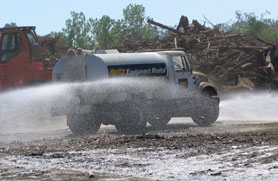
- Do not remove ash until it has cooled and it no longer contains hot spots
- Remove flammable and combustible materials from around the area where ash is being handled
- Consider maintaining a fire watch while removing materials
- Where construction and demolition debris may be mixed with vegetative debris, test the ash for hazardous components before removal
- Use water spray or mist to suppress dust generation
Additional Personal Protective Equipment
-
Evaluate the need to revise protective clothing, respirator, eye, and glove selection for additional thermal and ash protection
Key Engineering Controls and Work Practices
- Identify building materials such as painted surfaces and pipes that may contain lead. Test materials as necessary
- Based on test results, perform an worker exposure assessment of the planned activities, that includes air monitoring and/or objective data, to determine if lead dust or fume may be generated at or above OSHA's action level (0.03 milligrams of lead per cubic meter of air (mg/m3))
- If so, then the activities must be done in compliance with 29 CFR 1926.62. This would include:
- Establishing a written lead compliance program
- Having a competent person conduct frequent and regular inspections of the jobsite, materials, and equipment
- Sampling worker exposures
- Using special equipment or methods to decrease lead-dust generation such as local exhaust ventilation, dust collection systems (on power tools), and good housekeeping practices
- Providing respiratory protection and protective work clothing
- Providing medical exams and blood tests before work begins and every six months, as necessary
- Ensuring that workers wash their hands and face before eating, drinking, and smoking
- Setting up and ensuring use of change areas and eating facilities that are separate from the work area
-
Limiting the wearing of lead-contaminated clothing in eating areas or away from the job site
- During certain tasks, workers must be treated as if they are exposed above the OSHA PEL (0.05 mg/m3) until an exposure assessment, which includes air sampling, is performed. For each of these tasks, OSHA has identified an exposure level on which to base decisions until an exposure assessment is complete. If planned activities include any of the tasks below, you must provide the following items while the exposure assessment is being performed: respiratory protection and PPE identified in 29 CFR 1926.62(d)(2), change areas, hand washing facilities, training, and biological monitoring. These tasks include:

- Where lead coatings or paint are present: manual demolition, scraping, and sanding; heat gun applications; power tool cleaning (with or without dust collection systems); cleanup activities where dry expandable abrasives are used; rivet busting; abrasive blasting (including enclosure movement or removal); welding; cutting; and torch burning
- Spray painting with lead paint
- Using lead containing mortar
- Lead burning
Additional Personal Protective Equipment
- Based on anticipated exposure, select respirator and protective clothing as required in 29 CFR 1926.62 for initial sampling and subsequent work where lead dust or fumes may be generated
Key Engineering Controls and Work Practices
- Remove flammable and combustible materials from the area
- Do not perform "hot work" such as welding, cutting, or burning in areas where flammable, combustible, corrosive, or toxic substances are being used, stored, or may otherwise be present
- Maintain a fire watch during all hot work until material has cooled
- Ensure fire extinguishers and extinguishing agents are available in the immediate area
- Provide natural, exhaust, or forced ventilation to control exposure to the metal fumes and other contaminants being generated (e.g., generator exhaust)
- Ensure that pipes and other vessels are purged of hazardous materials
- Identify building materials that will be welded, cut, or burned and that may contain lead, such as painted surfaces and pipes. Test materials and provide exposure controls identified in 29 CFR 1926.62 as necessary-see Lead hazards
Additional Personal Protective Equipment
- Gloves and protective clothing for the activity being performed
- At a minimum, filtered lenses and face-protection as appropriate for the activity being performed
- Respiratory protection based on anticipated exposure to metal fumes, including lead
Key Engineering Controls and Work Practices
- Use ground-fault circuit interrupters (GFCIs) or double insulated power tools, or implement an assured equipment grounding program
- Inspect power tool condition (including any cords) and verify operation of safety features before use
- Do not use equipment that is defective, such as equipment with inoperable safety switches, missing guards, frayed/cut cords etc.
- Ground power tools properly
- Avoid standing in wet areas when using portable power tools
Additional Personal Protective Equipment
- Hearing protection-see Noise hazards
- Hand protection for cut- and abrasion -control and vibration dampening
- Eye protection appropriate to the impact hazard
Key Engineering Controls and Work Practices
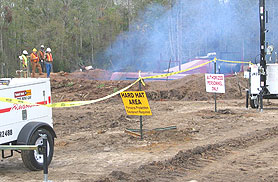
- Never attach a generator directly to the electrical system of a structure unless a qualified electrician has installed a transfer switch for the generator. If the structure's electrical system is not isolated, it may energize the utility's wiring system for great distances and create a risk of electrocution for utility workers and others in the area
- Always plug electrical equipment directly into the generator using the manufacturer's supplied cords or grounded (3-pronged) extension cords that are rated for the total anticipated load
- Do not overload a generator; it can overheat and create a fire hazard
- Ground and bond generators according to the manufacturer's recommendations; ensure that any manufacturer-required connections are secure before using the generator
- Keep the generator dry; protect with a canopy if needed; do not use it in wet or rainy conditions
- Carbon monoxide (CO) is a poisonous, colorless, and odorless gas that is produced by the incomplete burning of the generator's fuel. CO is harmful when breathed because it displaces oxygen in the blood and deprives the heart, brain, and other vital organs of oxygen
- Never use a generator indoors or in enclosed spaces such as garages and basements; opening windows and doors may not prevent CO from building up in those spaces. Do not use a generator outdoors near doors, windows, and vents that could allow CO to enter
- Ensure that a generator has 3 to 4 feet of clear space on all sides and above it to ensure adequate ventilation and cooling
- Before refueling, shut down the generator and allow it to cool
Additional Personal Protective Equipment
-
Hearing protection-see Noise hazards
Key Engineering Controls and Work Practices
-
Place generators, compressors, and other noisy equipment at a distance or behind a barrier when possible
Additional Personal Protective Equipment
-
Hearing protection when working around potential noise sources and when noise levels exceed 90 dBA. A useful "rule of thumb"-if you cannot hold a conversation in a normal speaking voice with a person who is standing at arms length (approximately 3 feet), the noise level may exceed 90 dBA
Key Engineering Controls and Work Practices
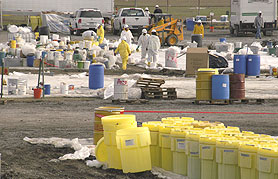
- Segregate and store incompatible chemicals separately. For example, store solvents and oxidizers (e.g., peroxides) separately, and acids and caustics separately
- Secure compressed gas cylinders and ensure that they are stored properly when not in use (regulators off and valve caps on when not in use; separate oxygen and fuel gas by 20 feet or using a non-combustible barrier (5 ft high, fire-resistant rating of at least ½ hour))
- Store chemicals in containers approved and designed for chemical storage and mark all storage locations
- Ensure that materials (e.g., Freon�, oils, and fuels) to be recycled or disposed are handled using appropriate precautions
- Store and handle hazardous materials in areas with natural or forced ventilation; do not store or handle in low-lying areas
- Isolate, secure and identify storage areas
- Prohibit smoking near storage areas
- Keep ignition sources at least 25 feet away from storage areas
- Ensure that fire extinguishers and extinguishing agents are available in the immediate area
- Bond and ground containers before dispensing flammable liquids. [29 CFR 1926.152(e)(2)]
Additional Personal Protective Equipment
- Gloves made of material that will protect user from chemicals handled
- Face shield or goggles with indirect venting. If a face shield is selected, eye protection must be worn under the face shield
- Coveralls or apron resistant to chemicals being handled
- Disposable boot covers resistant to the chemicals being handled
- A respirator and cartridges specific for chemical, as necessary
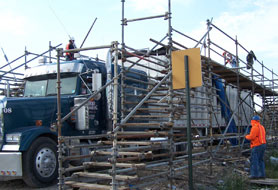
Select any of the following potential hazards that can be associated with this activity in order to access relevant recommendations in the general recommendations document:
Additional Medical Needs
- Follow medical guidance and precautions outlined in the general recommendations document
- Workers who may be exposed above the action level for lead for a single day must be enrolled in an initial medical surveillance program. Additionally, workers who are exposed to lead levels at or above the action level for more than 30 days in any consecutive 12 months must be enrolled in a medical surveillance program, as outlined in 29 CFR 1926.62(j)
Additional Training Needs
- Follow general site- and task-specific training guidelines as outlined in the general recommendations document
- Workers shall be provided lead training before starting work involving lead exposures at or above the action level. See the general recommendations document and or 29 CFR 1926.62(l) for additional lead-specific training information
Related Activity Sheets
- Debris Collection
- Tree Trimming
- Vehicle Removal and Salvage
- Sand and Sludge Removal
- Trenches and Excavations
- Heavy Equipment and Powered Industrial Truck Use
- Work Zone Safety and Traffic Control within a Work Area
- Crane Use
Other Resources and References
- 29 CFR 1910.178, Powered industrial trucks. OSHA Standard.
- 29 CFR 1910.1025, Lead. OSHA Standard.
- 29 CFR 1910.134, Respiratory protection. OSHA Standard.
- 29 CFR 1926 Subpart H, Materials handling, storage, use, and disposal. OSHA Standard.
- 29 CFR 1926 Subpart O, Motor vehicles, mechanized equipment, and marine operations. OSHA Standard.
- 29 CFR 1926 Subpart P, Excavations. OSHA Standard.
- Working Safely with Chain Saws. OSHA Fact Sheet, (2005).
- Carbon Monoxide Poisoning. OSHA Quick Card, (2005).
- Using Portable Generators Safely. OSHA Fact Sheet, (2005).
- Work Zone Traffic Safety. OSHA Quick Card,(2005).
- Hand and Power Tools. OSHA Safety and Health Topics Page.
- Fire Safety. OSHA Safety and Health Topics Page.
- Respiratory Protection. OSHA Safety and Health Topics Page.
- Manual on Uniform Traffic Control Devices (MUTCD). US Department of Transportation, Federal Highway Administration.
- Storm, Flood and Hurricane Response. National Institute for Occupational Safety and Health (NIOSH) Workplace Topic.
- NIOSH Respirator Selection Logic. National Institute for Occupational Safety and Health (NIOSH) Publication 2005-100, (October 2004).
- NIOSH's Pocket Guide to Chemical Hazards. National Institute for Occupational Safety and Health (NIOSH) Publication 2005-149, (September 2005).

